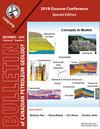西北地区科尔维尔山早-中寒武纪风暴影响的坝状岸面演替沉积学和沉积技术
Q3 Earth and Planetary Sciences
引用次数: 10
摘要
摘要本文首次对加拿大西北地区Colville Hills地区的寒武纪Mount Clark组进行了详细的沉积学和技术研究。通过对4个工业岩心的分析,确定了8个岩相,形成了一个循环相组合。这种相组合记录了沉积前积风暴影响的岸面演替,保存了近海到上岸面的沉积环境。风暴的影响表现在丘状交叉层状(HCS)和由低角度交错层状砂岩和薄生物扰动互层组成的风暴/晴朗天气对联的存在。海相洪泛面表现为分离近岸和上覆海相沉积环境的含砾海侵滞后面。管道岩是常见的,代表了最受石油污染的岩性,并保存在以波浪为主的岸面演替中。该序列的沉积学和技术特征表明,研究区克拉克山组具有可预测的滨面堆积模式和砂岩分布特征。本文章由计算机程序翻译,如有差异,请以英文原文为准。
Sedimentology and ichnology of an Early-Middle Cambrian storm-influenced barred shoreface succession, Colville Hills, Northwest Territories
Abstract This study presents the first detailed sedimentological and ichnological study of the Cambrian Mount Clark Formation from the Colville Hills region of the Northwest Territories, Canada. Based on analyses of four industry drill cores, eight lithofacies are identified that occur in a recurring facies association. This facies association records a progradational storm-influenced shoreface succession preserving offshore to upper shoreface sedimentary environments. Storm influence is indicated by the presence of hummocky cross-stratification (HCS) and of tempestite/fair-weather couplets consisting of low-angle cross-bedded sandstone with thin bioturbated interbeds. Marine flooding surfaces are expressed as pebbly transgressive lags that separate near-shore and overlying offshore sedimentary environments. Piperock is common, represents the most oil stained lithology, and is preserved within a wave-dominated shoreface succession. The sedimentological and ichnological character of this succession suggests that predictable shoreface stacking patterns and sandstone distributions characterize the Mount Clark Formation in the subsurface of the study region.
求助全文
通过发布文献求助,成功后即可免费获取论文全文。
去求助
来源期刊

Bullentin of Canadian Petroleum Geology
Earth and Planetary Sciences-Geochemistry and Petrology
CiteScore
2.50
自引率
0.00%
发文量
0
期刊介绍:
The Bulletin of Canadian Petroleum Geology is a peer-reviewed scientific journal published four times a year. Founded in 1953, the BCPG aims to be the journal of record for papers dealing with all aspects of petroleum geology, broadly conceived, with a particularly (though not exclusively) Canadian focus. International submissions are encouraged, especially where a connection can be made to Canadian examples.
 求助内容:
求助内容: 应助结果提醒方式:
应助结果提醒方式:


